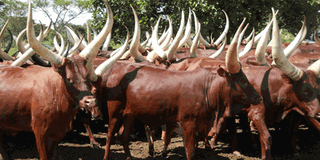Prime
Cattle farmers count losses after drought

Prolonged dry seasons of the kind that was experienced from late last year through to the first quarter of this year have had a a big impact on the sizes of herds of cattle in several parts of the country. FILE PHOTO.
What you need to know:
The long dry spell that hit the country led to the drying up of pastures and water sources for livestock. Now farmers are suffering the effects, writes Fred Muzaale
Mr Godfrey Niyemanya, a resident of Kasokwe village in Galilaaya Sub-county, Kayunga District, sits on his verandah in deep thought. With a big mug, he drinks dry tea as flies hover around four fresh cow-skins which are spread in his spacious compound to dry.
Just three months ago, Niyemanya boasted of a cattle farm with 102 heads of cattle but his current misery stems from a recent loss of 57 heads of cattle due to the long drought, which resulted into the drying up of pasture and water sources. All his cattle are local breeds.
Like in other parts in the country that were affected by the La Niña phenomenon, which started in October last year and lasted up to late March, the semi-arid area of Bbale county in Kayunga district was badly affected. It is located within the cattle corridor.
Mr Niyemanya, who is the newly elected District Councillor for Galilaaya sub-county, explains his ordeal as tears roll down on his cheeks. ”I had more than 100 heads of cattle on my farm from which I obtained about 100 litres of milk daily, which fetched me on average Shs50,000 a day and about Shs1.5m a month.”
From the money that he obtained from selling milk, he would pay school fees for his five children—two of them in secondary school, one at university and the rest in primary school.
With such an income, he was living a fairly happy life as he was able to purchase essential commodities like soap, sugar, clothes and also pay for healthcare for his family.
When drought struck the area, pasture started withering and water dams and other water sources begun drying up. By the end of the previous year, this had caused starvation among animals.
“The cattle that were healthy became emaciated and weak and most of them, especially the aged ones, could not walk to the banks of river Nile; the only remaining area where they would get water for drinking.”
He adds, “The cattle that became stranded died one by one as they could not get what to eat and we could not also get anything for them to eat.”
During that period, as a way to cope with the situation, some of the cattle were sold off. A big bull was going for a mere Shs100,000 from the usual Shs700,000 while the other cattle were being bought at a lowly Shs40,000.
Mr Niyemanya laments that by the end of the drought, he had remained with less than half of the herd on his farm.
“Currently I have only 45 heads of cattle and I drink dry tea because I don’t have milk anymore. Recently, I was rescued by friends who lent me money which I used to pay tuition fees for my eldest son. Life is no longer the same,” he says.
Like Mr Niyemanya, many other farmers in Bbale county were similarly affected by the drought. Kayunga District Naads Coordinator, Mr Ali Lule, puts the number of animals lost in the area during the drought period to about 500. He puts the number of farmers who were affected by the drought at about 2,000.
Mr Peter Ssentongo, a resident of Bweyale village in Galilaaya sub-county, says he lost six of the 45 animals that he had on his farm. He feels that he was lucky to have lost a few because he had sold off the aged ones during the 2010 festive season before the drought struck.
Because most crops dried up, food security in the area has worsened, forcing many families to switch to one meal a day. “Many people in this area now drink porridge for lunch and those who are lucky will have one meal a day,” says Mr Boniface Bandikubi, the Kayunga District Speaker.
Mr Bandikubi observes that even though the area has begun receiving rains, the situation is still bad as farmers are just planting crops.
“Government should offer relief food items and improved seeds to residents as a short-term remedy to the situation or else we are about to see people dying of hunger,” the district speaker opines.
How to avoid livestock losses during dry spells
The Kayunga District Director for Production, Dr David Mugabi, advises cattle keepers to always take precautionary measures to avoid such losses.
By making hay during rainy seasons and keeping it to feed their animals during dry periods.
The first thing that a farmer needs in order to make hay is an adequate size of land to grow grass on.
Fast-growing grasses like elephant grass can be used and should basically be kept weed free.
Mow the grass and leave it to lay for a day. After, the grass should be turned over using a rake and allowed to dry for another day or two. Then, it can either be square- or round-baled.
Silage (hay) consists of green forage that is preserved by fermentation under high moisture content for use as succulent fodder during periods of feed scarcity.
The material is normally stored in pits under anaerobic conditions (absence of oxygen) and naturally produced organic acids, chiefly lactic acid, which preserve the fodder.
Dr Mugabi also advises that farmers should adopt a system of raising not more than three high-breed animals that can give them a lot of milk. These three animals can be reared on a small piece of land and can be managed easily.
Livestock breeds like Friesian and Jersey can produce 30-45 litres of milk a day compared to about two litres that a local cow can produce a day.
He also adds that government should construct community water dams and also de-silt those in the area so that animals can get clean water to drink.
Farmers should construct granaries or stores to keep some of the food for future use and refrain from selling off their food.
Mr James Rwebikire, a Naads official and cattle keeper in Kayunga sub-county, also advises that during drought, livestock should be taken to graze very early in the morning.
At that time, the available palatable grass is still soaked with dew. Since the foliage is soaked with dew, this reduces the rate at which the animals drink water.
Mr George Kinaalwa of Ngogwe village in Buikwe district adds that before the beginning of a drought, a farmer with a big herd can sell off some of the cattle.
The farmer should remain with a herd he can manage properly.
He says that aged cattle and those that can no longer provide the expected amounts of milk can be sold off.




